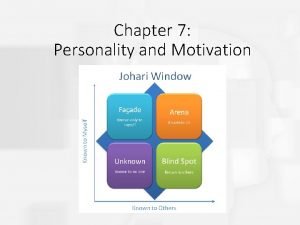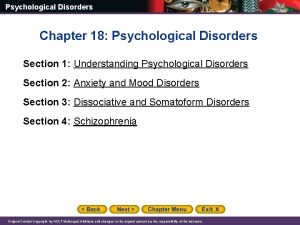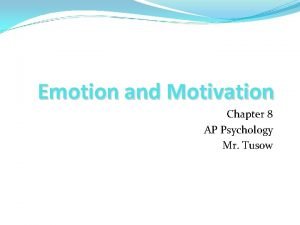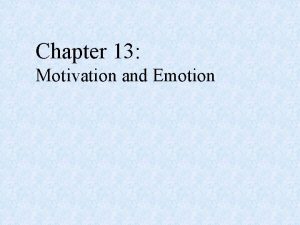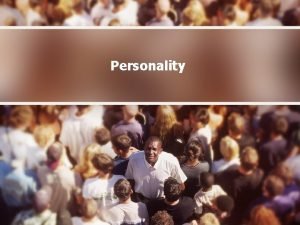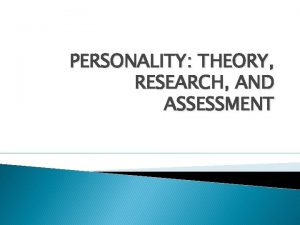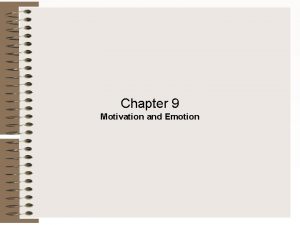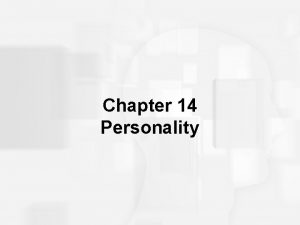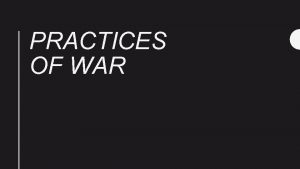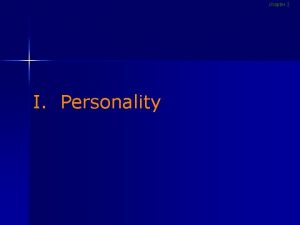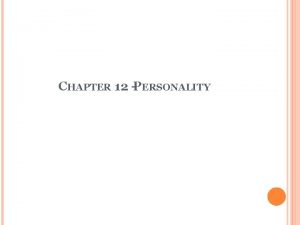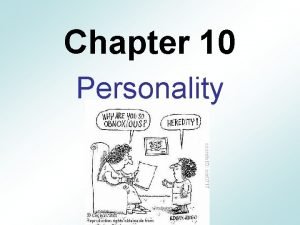Chapter 7 Personality and Motivation Defining Some Terms



















- Slides: 19

Chapter 7: Personality and Motivation

Defining Some Terms • Personality: A person’s unique and relatively stable behavior patterns; the consistency of who you are, who you have been, and will become • Character: Personal characteristics that have been judged or evaluated • Temperament: Hereditary aspects of personality, including sensitivity, moods, irritability, and adaptability • Personality Trait : Stable qualities that a person shows in most situations • Self Concept: Your ideas, perceptions, and feelings about who you are • Personality Theory: System of concepts, assumptions, ideas, and principles proposed to explain personality; includes four perspectives

Personality Theories: An Overview • Trait Theories - Attempt to learn what traits make up personality and how they relate to actual behavior • Psychodynamic Theories - Focus on the inner workings of personality, especially internal conflicts and struggles • Humanistic Theories - Focus on private, subjective experience and personal growth

Personality Types The four basic temperaments recognized by ancient Greeks: • Melancholic (introverted + unstable): sad, gloomy • Choleric (extroverted + unstable): hot-tempered, irritable • Phlegmatic (introverted + stable): sluggish, calm • Sanguine (extroverted + stable): cheerful, hopeful

Personality Types • Carl Jung, Swiss psychiatrist who was a Freudian disciple, believed that we are one of two personality types: • Introvert: Shy, selfcentered person whose attention is focused inward • Extrovert: Bold, outgoing person whose attention is directed outward

Freud’s Psychoanalytic Theory: The Id • Made up of innate biological instincts and urges; selfserving, irrational, and totally unconscious • Works on Pleasure Principle: Wishes to have its desires (pleasurable) satisfied now, without waiting and regardless of the consequences • The child-like aspect of our personality

Freud’s Psychoanalytic Theory: The Ego • Executive; directs id energies • Partially conscious and partially unconscious • Works on Reality Principle: Delays action until it is practical and/or appropriate • The mediator between Id and Super-ego when conflict arises

Freud’s Psychoanalytic Theory: The Superego • Judge or censor for thoughts and actions of the ego • Superego comes from our parents or caregivers; guilt comes from the superego • Two parts • Conscience: Reflects actions for which a person has been punished • Ego Ideal: Second part of the superego; reflects behavior one’s parents approved of or rewarded


Unconscious et al • Unconscious: Holds repressed memories and emotions and the id’s instinctual drives • Conscious: Everything you are aware of at a given moment • Preconscious: Material that can easily be brought into awareness

Cause of Anxiety Ego is always caught in the middle of battles between superego’s desires for moral behavior and the id’s desires for immediate gratification Neurotic Anxiety: Caused by id impulses that the ego can barely control Moral Anxiety: Comes from threats of punishment from the superego Defense mechanism: a process used by the ego to distort reality and protect a person from anxiety

Examples of Defense Mechanisms Regression: Ego seeks the security of an earlier developmental period in the face of stress. Displacement: Ego shifts unacceptable feelings from one object to another, more acceptable object. Sublimation: Ego replaces an unacceptable impulse with a socially acceptable one Reaction Formation: Ego transforms an unacceptable motive or feeling into its opposite. Projection: Ego attributes personal shortcomings, problems, and faults to others. Rationalization: Ego justifies an unacceptable motive by giving a false acceptable (but false) reason for behavior

Humanism • Approach that focuses on human experience, problems, potentials, and ideals • Human Nature: Traits, qualities, potentials, and behavior patterns most characteristic of humans • Free Choice: Ability to choose that is NOT controlled by genetics, learning, or unconscious forces • Subjective Experience: Private perceptions of reality

Carl Rogers’ Self Theory • Exists when there is a discrepancy between one’s experiences and self-image, or between one’s self-image and ideal self • Ideal Self: Idealized image of oneself (the person one would like to be) Incongruence • Fully Functioning Person: Lives in harmony with his/her deepest feelings and impulses • Self: Flexible and changing perception of one’s identity • Self-Image: Total subjective perception of your body and personality; self-concept


Motivation • A need or desire that energizes and directs behavior toward a goal Drive • An aroused state that typically arises from an underlying need Incentives • Positive or negative environmental stimuli that motivate behavior

Maslow’s Theory • Abraham Maslow is considered father of the humanistic movement. He observed the lives of (purportedly) healthy and creative people to develop is theory. • Hierarchy of needs: the motivational component of Maslow’s theory, in which our innate needs, which motivate our actions, are hierarchically arranged. • Self-actualization: the fullest realization of a person’s potential

Graphic: Hierarchy of Needs

Characteristics of Self-Actualized People • • • Efficient perceptions of reality Comfortable acceptance of self, others, and nature Spontaneity Task Centering Autonomy Continued freshness of appreciation Fellowship with humanity Profound interpersonal relationships Comfort with solitude Non-hostile sense of humor Peak experiences
 Examples of defining and non defining clauses
Examples of defining and non defining clauses Relative clauses defining and non defining
Relative clauses defining and non defining Non-defining relative clauses
Non-defining relative clauses Defining and non defining relative clauses in telugu
Defining and non defining relative clauses in telugu Defining and non defining relative clauses
Defining and non defining relative clauses Defining non defining farkı
Defining non defining farkı Defining terms geometry
Defining terms geometry Q3. define personality and motivation.
Q3. define personality and motivation. Polynomial classification
Polynomial classification Identify the terms and like terms in the expression. t+8+3t
Identify the terms and like terms in the expression. t+8+3t Contact vs noncontact forces
Contact vs noncontact forces Some may trust in horses
Some may trust in horses They say it only takes a little faith
They say it only takes a little faith They say sometimes you win some
They say sometimes you win some Cake is countable or uncountable
Cake is countable or uncountable Some say the world will end in fire some say in ice
Some say the world will end in fire some say in ice Some say the world will end in fire some say in ice
Some say the world will end in fire some say in ice The separation of some personality components
The separation of some personality components Cognitive appraisal psychology definition
Cognitive appraisal psychology definition Chapter 13 motivation and emotion
Chapter 13 motivation and emotion







